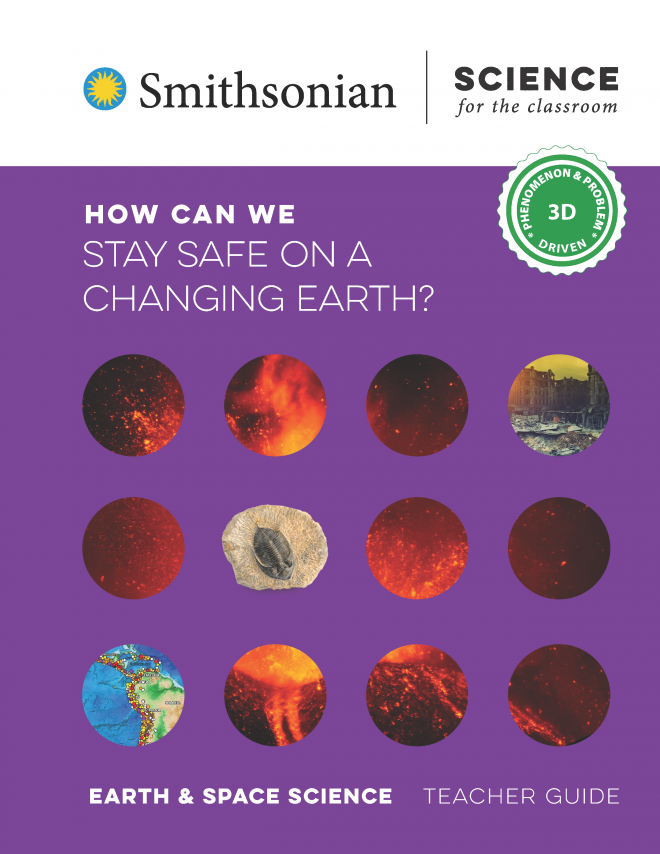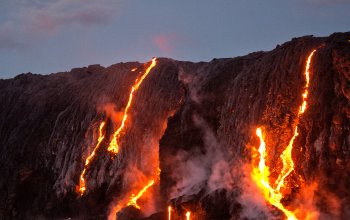How Can We Stay Safe On A Changing Earth?
How Can We Stay Safe On A Changing Earth?
How Can We Stay Safe on a Changing Earth? is part of Smithsonian Science for the Classroom, a curriculum series by the Smithsonian Science Education Center. It is designed to address a bundle of grade 4 standards. In this module, students:
- Investigate weathering and erosion processes and explain the roles these processes have in changing the landscape and revealing fossils.
- Obtain information about the hazards associated with tsunamis and landslides and ways humans minimize hazards caused by such Earth processes.
- Explain differences between typical ocean waves and tsunami waves, including their causes and the patterns they follow.
- Design solutions to prevent landslides on a mountainside after a wildfire destroys plant life.
- Develop a tool to evaluate sites for landslide risk to propose a location for a mountain-themed amusement park.
Below are digital resources that support teaching of this module.
Family Letter
Before starting How Can We Stay Safe on a Changing Earth?, share the Family Letter with students’ caregivers. Indicate how they should submit responses to the letter.
Download the Family Letter PDF
Fern Fossil
This file contains an image of a fern fossil embedded in red shale from the Grand Canyon.
Download the Fern Fossil PDF
Grand Canyon (:08 minutes)
This video shows clouds moving over the Grand Canyon.
Download the Grand Canyon Video
Download the Accessible Version of the Grand Canyon Video
Download the Grand Canyon Transcript
Tsunami Wave (:06 minutes)
This video shows a large tsunami wave crashing over tall buildings to serve as a partial introduction to the phenomenon.
Download the Tsunami Wave Video
Download the Accessible Version of the Tsunami Wave Video
Download the Tsunami Wave Transcript
World Map (Labeled)
This file shows a world map centered on the Atlantic Ocean and has the locations of Hilo, Hawaii, and Onagawa, Japan labeled.
Download the World Map (Labeled) PDF
Wave Damage
This file contains several images of damage done by tsunami waves.
Download the Wave Damage PDF
Investigating Waves
This file contains text with questions about waves to be used during the investigation and class discussion.
Download the Investigating Waves PDF
Tsunami Simulator
This link contains a simulation of typical ocean waves and tsunami waves for students to observe and manipulate. Login to Carolina Science Online to access this digital resource.
Play Tsunami Simulator
Tsunami Sim Instructions
This file contains discussion questions for students as they explore the simulation.
Download the Tsunami Sim Instructions
Wave Diagram
This file shows an image of the wave diagram from students’ notebook sheets to label together as a class during discussion.
Download the Wave Diagram PDF
Tsunami Signs
This link provides access to examples of tsunami warning and evacuation signs from several locations.
http://itic.ioc-unesco.org/index.php?option=com_content&view=article&id=1603&Itemid=2321
School Earthquake Safety
This link provides information about school earthquake safety under the heading Preparedness and Safety Resources.
https://www.unesco.org/en/disaster-risk-reduction/school-safety
Drop Cover Hold On
This link provides resources for earthquake safety for people with disabilities.
https://www.fema.gov/fact-sheet/key-earthquake-safety-tips-people-disabilities
World Map (Blank)
This file contains a blank map that can be annotated with student ideas about patterns they find in the occurrence of Earth processes.
Download the World Map (Blank) PDF
Earth Event Locations
This file contains an image of the Earth Event Locations card from the Global Map card set to be used during class discussion.
Download the Earth Event Locations PDF
Natural Hazards Viewer
This website allows you to search for several different types of natural disasters. To prepare the site for the Lesson 7 extension, select the Reset All Filters button on the lower left side of the viewer. Then select the check box next to Significant Earthquakes, Significant Volcanic Eruptions, or both. Use the search button for each of these hazards to limit the search to one year, possibly the year most of your students were born. Select specific events and access the information for students or prepare to show the viewer to the class and have them guide the selection.
https://www.ncei.noaa.gov/maps/hazards/
Pacific Ocean Map
This file contains a map centered on the Pacific Ocean to help introduce the phenomenon.
Download the Pacific Ocean Map PDF
Ship on the Ocean (0.18 minutes)
This video shows a ship floating up and down on regular ocean waves.
Download the Ship on the Ocean Video
Download the Accessible Version of the Ship on the Ocean Video
Download the Ship on the Ocean Transcript
Chain Wave (0:12 minutes)
This video shows the movement of the chain wave model to use for class discussion of students’ investigations.
Download the Chain Wave Video
Download the Accessible Version of the Chain Wave Video
Download the Chain Wave Transcript
California News Clipping
This file contains a news article describing the problem of a town worrying about mudslides in the aftermath of nearby forest fires.
Download the California News Clipping PDF
Hillside Forest Fire (0:42 minutes)
This video shows a forest fire and the aftermath of the fire on a hillside to serve as a partial introduction to the problem.
Download the Hillside Forest Fire Video
Download the Accessible Version of the Hillside Forest Fire Video
Download the Hillside Forest Fire Transcript
Mudslide (0:11 minutes)
This video shows mud flowing downhill to provide a visual of the problem.
Download the Mudslide Video
Download the Accessible Version of the Mudslide Video
Download the Mudslide Transcript
Rain Gardens
This is a collection of links to websites related to designing and building rain gardens.
http://www.groundwater.org/action/home/raingardens.html
https://www.nwf.org/Magazines/National-Wildlife/2015/AugSept/Gardening/Rain-Gardens
http://www.chesapeakeecologycenter.org/rainscaping-org/
https://www.epa.gov/soakuptherain/soak-rain-rain-gardens
Landslide Solutions
This file contains images of all the materials available for students’ solutions on the Landslide Solutions card set, to be used for class discussion.
Download the Landslide Solutions PDF
Hydroseeding
This file contains images of a hydroseeded hill with the hose used to spray the mixture to provide students a visual of how hydroseeding mixtures are applied.
Download the Hydroseeding PDF
Mountain Park (1:58 minutes)
This video contains several clips of mountainsides as a partial introduction to the problem.
Download the Mountain Park Video
Download the Accessible Version of the Mountain Park Video
Download the Mountain Park Transcript
Rubrics
This file contains a sample rubric for class discussion and topics for the landslide-risk rubrics.
Download the Rubrics PDF
Park Sites (1:49 minutes)
This video contains several clips of the landscape at two possible park locations: Oak Creek Canyon, Arizona, and Red River Gorge, Kentucky.
Download the Park Sites Video
Download the Accessible Version of the Park Sites Video
Download the Park Sites Transcript
Proposed Park Site
This StoryMap contains information students use to research landslide risk at the two proposed park locations. For the Theme Park Engineering extension, use this link and navigate to the Designing a Theme Park tab.
Visit the StoryMap




Kit Tips & Tricks